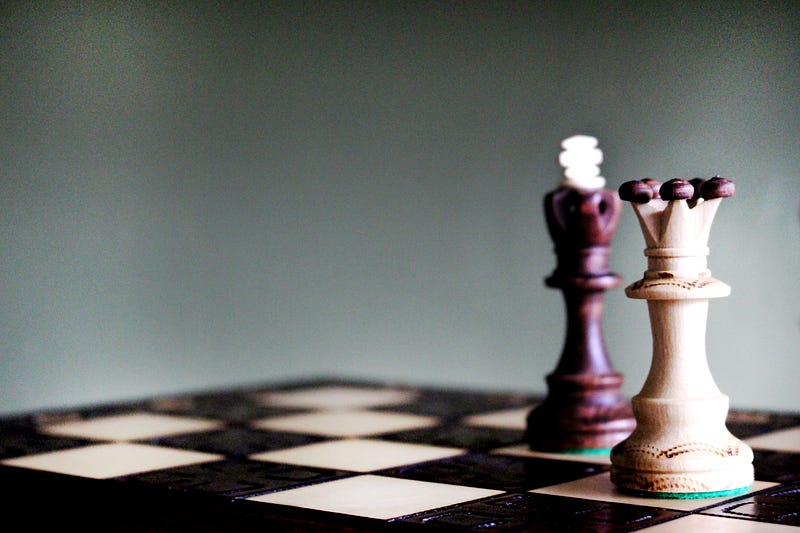Mastering Chess Notation: A Comprehensive Guide to Record Moves
Written on
Understanding Chess Notation
Are you fluent in the language of chess?
Grasping how to notate chess moves is a pivotal step toward enhancing your enjoyment of the game. Familiarizing yourself with the names of the squares and the notation symbols opens the door to solving puzzles in newspapers, following major tournaments (like the recent World Championship), and diving into chess theory.
Contrary to what many believe, learning chess notation is quite straightforward. I advocate for its importance through the chess club I lead, where both children and adults find it easily accessible.
Here's a concise guide to recording chess moves using standard algebraic notation (SAN):
Notation Fundamentals
Each move is documented as a combination of the piece being moved and its destination square. The pieces are represented by their initials: K for king, Q for queen, R for rook, B for bishop, N for knight, and no initial for pawns.
The squares are designated by their file (the column) and rank (the row) on the chessboard. The files are labeled a to h, while the ranks are numbered from 1 to 8, with white pieces starting with a rook on a1 and h1.
Recording Moves
Pawns: To log a pawn's movement, simply note the destination square. For instance, if a pawn advances to e4, you would write "e4".
Other Pieces: For other pieces, write the initial of the piece followed by the destination square. For example, if a knight moves to f3, you would document it as "Nf3".
Capturing Pieces
When a piece captures an opponent's piece, denote the capture with an "x". For instance, if a bishop takes a piece on d5, you would write "Bxd5".
Castling
Kingside castling is denoted as "O-O" and queenside castling as "O-O-O".
Disambiguation
When two identical pieces can move to the same square, specify which piece is moving. Use the file or rank of the starting square to clarify. For example, if two knights can move to d4, and one is on f3 while the other is on b1, you would write "Nfd4" or "Nbd4" to differentiate.
Check and Checkmate
If a move puts the opponent's king in check, append the "+" symbol. For example, if a bishop moves to e6 and checks the king, write "Be6+". For checkmate, use the "#" symbol—e.g., "Qh8#" if a queen moves to h8 to deliver checkmate.
Sample Moves
- e4: Pawn moves to e4.
- Nf3: Knight moves to f3.
- Bxd5: Bishop captures a piece on d5.
- O-O: Kingside castling.
- Nbd4: Knight from b1 moves to d4, clarifying which knight is in play.
- Be6+: Bishop moves to e6, checking the king.
- Qh8#: Queen moves to h8, achieving checkmate.
Maintaining accurate records of your moves is crucial. By using standard algebraic notation, you can effectively document and comprehend chess moves during your games.

The Importance of Notating Chess Moves
Recording your chess moves not only enhances your understanding of the game but also facilitates better analysis and learning. It allows for reflection on your gameplay, compliance with tournament rules, and participation in the chess community.
Personally, I cherish reviewing my childhood chess notation books to see how my skills have grown and to relive nostalgic memories from my school days. Here’s how notating moves can benefit you:
Analysis and Skill Development
Having a written record of moves allows for deeper game analysis. You can pinpoint critical moments, recognize tactical opportunities, and uncover positional errors. Reviewing these moves provides insights into your playing style, strengths, and areas for improvement.
Collaboration and Sharing
Notating your moves also enables discussions with coaches, fellow players, or online forums. It makes sharing and collaborating on game analysis easier, enhancing your understanding of the game.
Tournament Compliance
In formal chess tournaments, recording moves is often mandatory. This practice ensures fair play, prevents disputes, and provides a precise account of the game. It also becomes essential in situations like claiming a draw by repetition or invoking the fifty-move rule.
Enhancing Memory
Keeping track of moves can strengthen your memory and improve your visualization skills. By visualizing and replaying the game while noting the moves, you enhance your capacity to recall and manipulate chess positions mentally, which is valuable for calculating variations and exploring different strategies.
Historical Contribution
Chess has a rich legacy, and documenting your games contributes to this tradition. Your records may inspire others or serve as a resource for future players.
If you have additional tips or advice on chess, please share your thoughts in the comments to help grow the game!

To further enhance your chess notation skills, check out these videos:
Learning Chess Moves - Notate a Game
This video provides a clear and simple guide on how to notate chess moves effectively.
How to Write Chess Notation
This tutorial explains the intricacies of chess notation and its significance for players of all levels.
Thank you for reading!